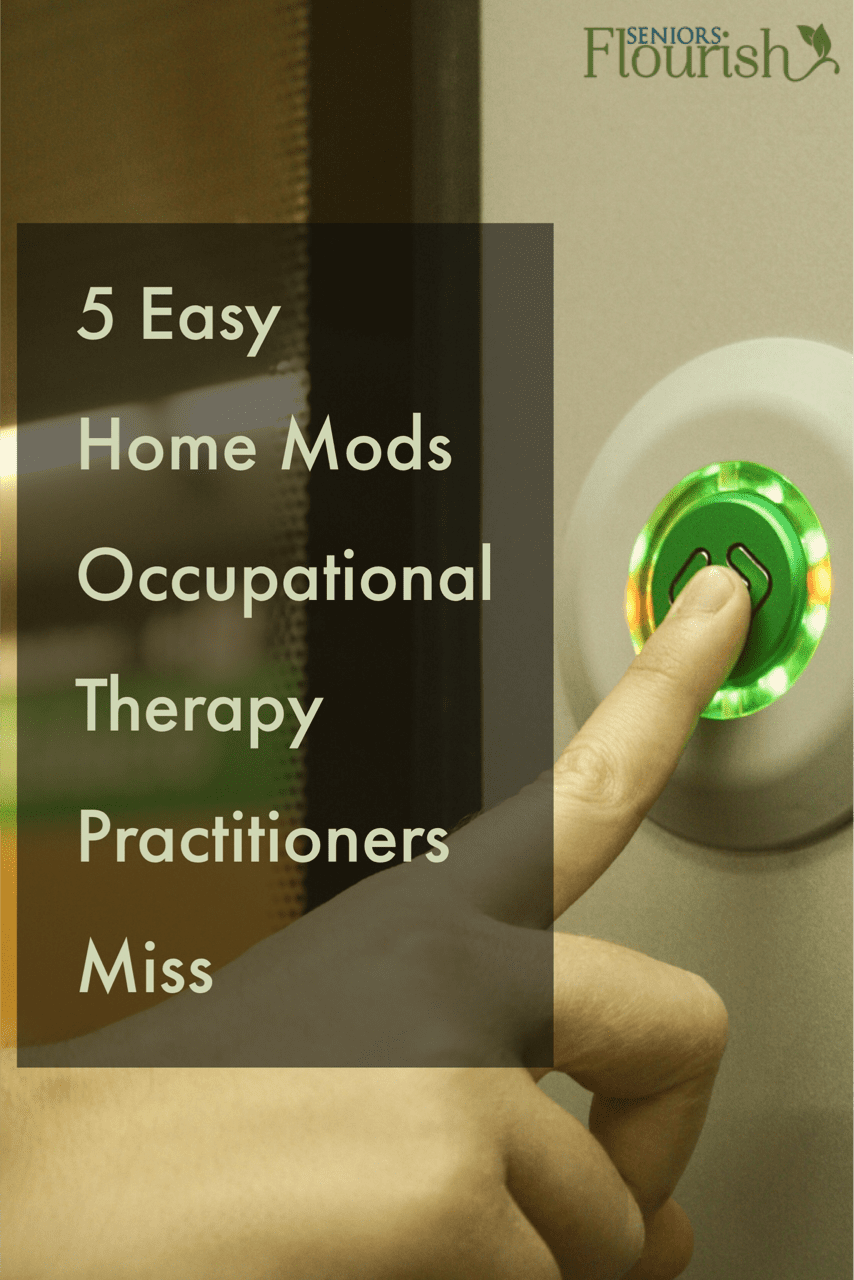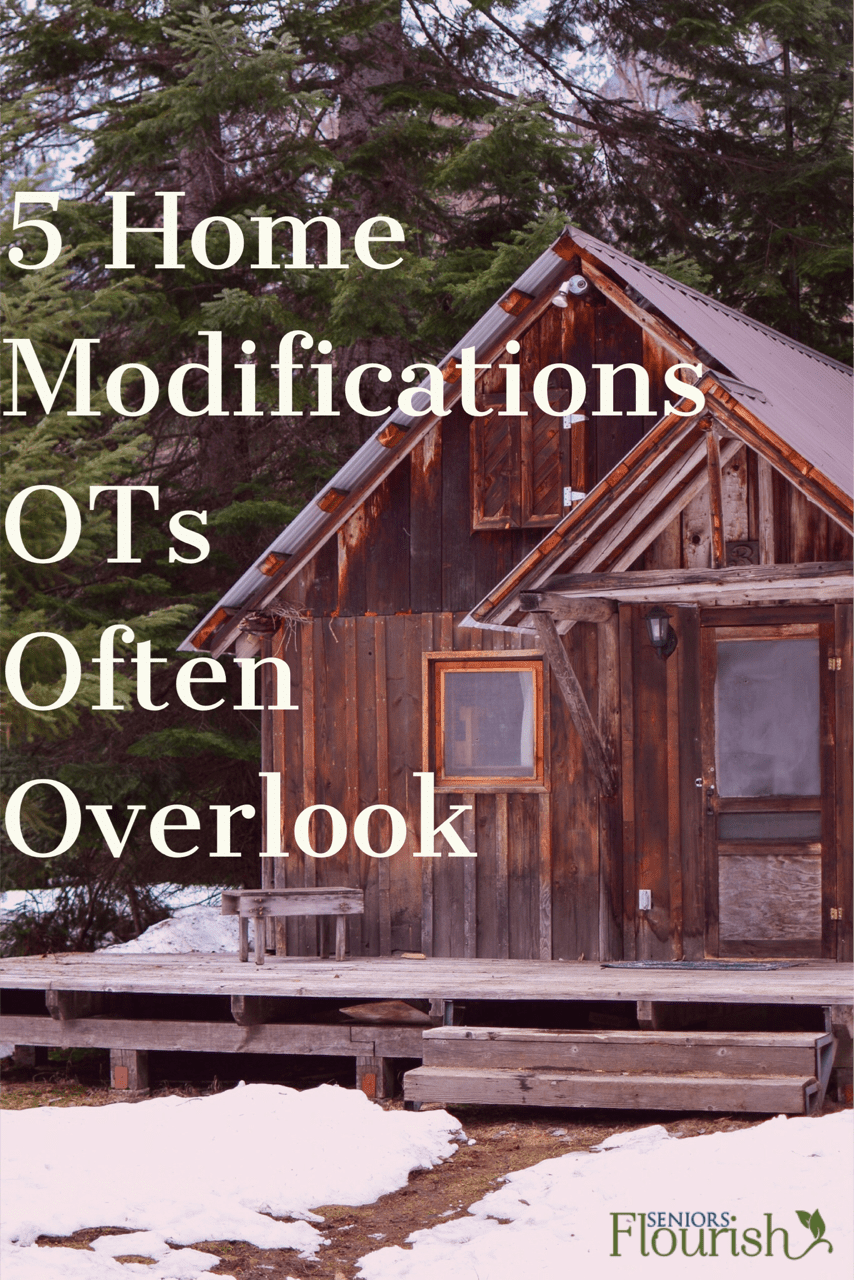Occupational therapy home modifications play a crucial role in enhancing safety and performance during daily activities at home. Occupational therapy practitioners are highly skilled in assessing the person-environment fit and making recommendations to support independence. We often take on many roles, such as teaching proper transfer techniques, helping organize kitchens for energy conservation, replacing door knobs with levers, and determining the best kind of shower chair or toilet seat.
Enhancing safety and independence through occupational therapy home modifications can make a significant difference in daily living.

There is growing evidence for the effectiveness of home modifications to improve safety and quality of life for older adults living at home. Stark et al. (2009) found that the use of a client-centered process to identify barriers and provide custom home modifications resulted in an increased satisfaction with the performance of daily tasks at home.
AARP (2000) reported in their National Survey of Housing and Modification Issues: Fixing to Stay that some of the most common modifications people make to their homes are increasing lighting with nightlights or increased light bulb wattage, replacing faucets and doorknobs with levers, installing non-skid materials in bathing areas and on stairs, adding handrails or grab bars, widening doorways, and adding ramps.
The easier the project, the more likely people were to implement the home modification.
A commonly reported barrier to home modifications is the lack of knowledge of the potential options by home owners, OTs, and building professionals.
Here are 5 simple occupational therapy home modifications to recommend to patient and families that are often overlooked:
1. Wireless Doorbell
- Problem: Typical doorbells can be hard to hear throughout the house, especially for people with hearing loss. The CDC reports that 15.3% of adults (about 37 million) in the US have some degree of hearing loss, with increasing prevalence as people age.
- Potential Solution: Doorbells have progressed over the last decade from simple push buttons that connect a wire and a “bell” to wireless devices that can be connected to one or multiple receivers. The adaptability of wireless doorbells makes them ideal for people with hearing loss because the “bell” can make noises of all volumes and varieties, vibrate, or flash lights (or even connect to cell phones).
- Details: Wireless doorbells are simple to install. The outside button is run by a battery and mounts with small screws. The inside receiver(s) also runs on batteries (or some plug in). It can be mounted to a wall, placed on a table, or held in a pocket.
- Cost starts at about $10.
- Details: Wireless doorbells are simple to install. The outside button is run by a battery and mounts with small screws. The inside receiver(s) also runs on batteries (or some plug in). It can be mounted to a wall, placed on a table, or held in a pocket.
2. Pathway Lighting
- Problem: People often have to navigate through dark areas of the home, which increases risk of falls and disorientation. This can be especially hazardous for people with visual deficits, mobility limitations, and cognitive impairments.
- Potential solution: Pathway lighting is low-level lighting to help people navigate in the dark without the need to turn on bright lights. It is frequently used to help people find a bathroom at night or for caregivers providing nighttime care. It can also helpful for people with dementia to orient to the correct path.
- Details: There are several simple options for pathway lighting that are easy to install. There are small, battery operated units that can be attached with small screws along any wall (motion sensory lights will use less batteries and last longer). Another option is to replace outlet faceplates with ones that have built-in LED lights that point downward. Rope lighting can also be used along a pathway, just make sure to secure it well to prevent tripping hazards.
- Cost starts at about $10
- Read about more high tech occupational therapy home modifications here
- Details: There are several simple options for pathway lighting that are easy to install. There are small, battery operated units that can be attached with small screws along any wall (motion sensory lights will use less batteries and last longer). Another option is to replace outlet faceplates with ones that have built-in LED lights that point downward. Rope lighting can also be used along a pathway, just make sure to secure it well to prevent tripping hazards.
3. Motion Sensor Lights
- Problem: Turning on lights in a room is a simple task that is often taken for granted. However, many people struggle for a variety of reasons. People with low vision can’t find the light switch. Caregivers often have their hands full and can’t reach a switch. People with mobility limitations often have their hands occupied by their mobility device. And, people with upper extremity impairments might find it physically challenging to reach a switch.
- Potential solution: Motion sensory lights can be useful in areas of the home where flipping a switch is challenging. Key areas would be laundry spaces, closets, hallways, inside cabinets, garages, hallways, and home entrances. Caution should be taken to not have sudden, bright lights that come on unexpectedly, as that may be a safety hazard.
- Details: The simplest way to achieve this is to mount small battery operated motion sensor lights in key areas. More complex would be to replace the current light switch with a motion sensor switch that will turn lights on/off automatically (please use caution with any electrical work). Additionally, light fixtures with built-in motion sensors that work in larger areas can be installed (particularly useful in outdoor or large rooms), but should be installed by a qualified electrician.
- Cost starts at about $10.
- Here are more high tech home modifications to recommend
- Details: The simplest way to achieve this is to mount small battery operated motion sensor lights in key areas. More complex would be to replace the current light switch with a motion sensor switch that will turn lights on/off automatically (please use caution with any electrical work). Additionally, light fixtures with built-in motion sensors that work in larger areas can be installed (particularly useful in outdoor or large rooms), but should be installed by a qualified electrician.
4. Entryway Bench
- Problem: One of the most challenging tasks reported by people with disabilities is being able to enter and leave their homes. This challenge is likely experienced by the 7.5% of adults (about 18 million) in the US who report difficulty with walking and the 16.3% of adults in the US(about 40 million) who report a physical functioning difficulty (CDC statistics).
- Potential solution: One easy way to make this task less daunting is to create a safe place to sit at the entry. This allows a person a place to sit to don and doff their shoes and outerwear, a place to store a bag without having to reach to the floor, and a place to rest while waiting for a ride.
- Details: Use of space is critical because most entrances have limited space. However, a safe place to sit should be given priority for people with mobility limitations, especially anyone who uses an assistive device. In larger homes, there is often room for a bench. In smaller homes, a chair will do just fine. Just remember that chairs or benches with arm rests will be easier for sit to stand transfers.
- Cost for a new bench or chair starts at about $50, but this idea can be free when repurposing furniture already in the home.
- Details: Use of space is critical because most entrances have limited space. However, a safe place to sit should be given priority for people with mobility limitations, especially anyone who uses an assistive device. In larger homes, there is often room for a bench. In smaller homes, a chair will do just fine. Just remember that chairs or benches with arm rests will be easier for sit to stand transfers.
5. Magnetic Doorstop
- Problem: Doors are a necessity in the home for security and privacy, but they are often a physical barrier for people with disabilities. In particular, doors that are heavy and/or swing shut can cause falls for people with balance and mobility impairments.
- Potential solution: One way to overcome this barrier is to have a way to keep doors securely open while passing through them. Doorstops come in all shapes and sizes, but an easy option is a magnetic door stop.
- Details: Magnetic doorstops come in two pieces- one attaches to the door and the other attaches to the floor or wall where the door should stop. When they connect, they stay together due to the magnetic force. They are easy to release by pulling apart once safely through the door. Most install with screws, and require basic handyman skills to ensure durability of the installation.
- Cost starts at about $10.
- Details: Magnetic doorstops come in two pieces- one attaches to the door and the other attaches to the floor or wall where the door should stop. When they connect, they stay together due to the magnetic force. They are easy to release by pulling apart once safely through the door. Most install with screws, and require basic handyman skills to ensure durability of the installation.
What do you feel we overlook when completing occupational therapy home modification assessments? Share your experiences below!
About the Author
Paige Hays is an OT from the Twin Cities, MN. She is a mother of 2 girls, avid DIYer, and a highly skilled and experienced OT. She specializes in working in home modifications for adults and children.
References:
- Stark, S., Landsbaum, A., Palmer, J., Somerville, E., & Morris, J. (2009). Client-centered home modifications improve daily activity performance of older adults. Canadian Journal of Occupational Therapy, 76, 235-245.
- Bayer, A. & Harper L. (2000). Fixing to stay: A national survey of housing and home modification issues. AARP.
- Disability statistics taken from the Center for Disease Control and Prevention website on July 23rd, 2017, https://www.cdc.gov/nchs/fastats/disability.htm






